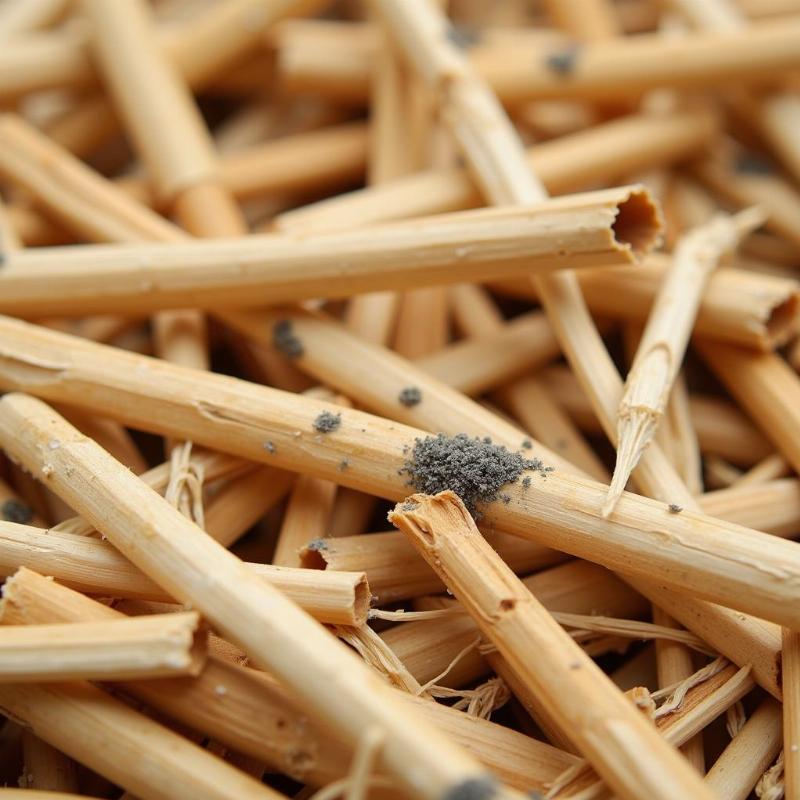Straw is a readily available and inexpensive bedding option, leading many dog owners to wonder if it’s suitable for their furry friends. While its affordability is attractive, straw isn’t the ideal choice for dog bedding. There are several important factors to consider before using straw, including your dog’s health, comfort, and safety. This article will delve into the pros and cons of straw bedding for dogs, explore superior alternatives, and guide you toward making the best choice for your canine companion.
Weighing the Pros and Cons of Straw Bedding
While straw might seem like a cost-effective bedding solution, it comes with its own set of advantages and disadvantages. Understanding these will help you make an informed decision.
Advantages of Straw
- Low Cost: Straw is generally cheaper than other bedding materials, making it an appealing option for budget-conscious pet owners.
- Absorbency: Straw can absorb moisture, which can be helpful in managing spills or accidents in your dog’s area.
Disadvantages of Straw
- Allergies and Respiratory Issues: Straw can be a significant allergen for dogs, triggering sneezing, coughing, and itchy skin. Dust and mold often present in straw can also exacerbate respiratory problems.
- Lack of Comfort: Straw is not soft and can be uncomfortable for dogs to lie on, especially for extended periods. This can be particularly problematic for senior dogs or those with joint issues.
- Potential for Ingestion: Dogs may ingest straw, which can lead to digestive upset, blockages, and even punctures in the gastrointestinal tract.
- Difficulty Cleaning: Straw is difficult to clean thoroughly and can harbor parasites and bacteria. Regular replacement is necessary, which can offset the initial cost savings.
- Fire Hazard: Dry straw is highly flammable and poses a fire risk, especially if near heat lamps or other heat sources.
 Straw dog bedding allergies
Straw dog bedding allergies
Exploring Better Bedding Alternatives for Your Dog
Fortunately, there are numerous alternatives to straw that provide a much safer and more comfortable environment for your dog. These options prioritize your dog’s health, comfort, and overall well-being.
Blankets and Towels
Soft, washable blankets and towels provide a comfortable and cozy sleeping surface. Choose materials that are durable and easy to clean.
Dog Beds
Specifically designed for dogs, dog beds come in various shapes, sizes, and materials to cater to different breeds and needs. Consider orthopedic beds for senior dogs or those with joint problems.
Cedar Shavings
Cedar shavings offer natural insect-repelling properties and a pleasant aroma. Ensure the shavings are sourced from kiln-dried cedar to minimize dust and allergens. However, some dogs can still be sensitive to cedar, so monitor your pet for any reactions.
Hemp Bedding
Hemp bedding is highly absorbent, biodegradable, and dust-free, making it a good option for dogs with allergies. It is also relatively durable and comfortable.
Addressing Common Concerns about Dog Bedding
What if my dog eats its bedding?
Choose a bedding material that is non-toxic and digestible if ingested in small amounts. Monitor your dog’s behavior and consult a veterinarian if you suspect they are ingesting large amounts of bedding.
How often should I change my dog’s bedding?
The frequency of bedding changes depends on the material and how quickly it becomes soiled. Generally, washable bedding should be cleaned weekly, while disposable bedding may need to be replaced more frequently.
Expert Insights on Dog Bedding
Dr. Emily Carter, a veterinarian specializing in canine care at the Animal Wellness Center in Austin, Texas, advises, “Choosing the right bedding is crucial for your dog’s health and comfort. Avoid using straw due to its potential for allergies and discomfort. Opt for a soft, clean, and easily washable material like a dog bed or blankets.”
She further adds, “If your dog spends time outdoors, consider investing in a well-insulated dog house with appropriate bedding for warmth during colder months. Prioritize your dog’s comfort and safety when selecting any bedding material.”
good dog houses for cold weather
Conclusion
While straw may seem like an economical choice for dog bedding, its potential drawbacks significantly outweigh the benefits. Prioritizing your dog’s comfort, health, and safety is paramount. By opting for safer and more comfortable alternatives like dog beds, blankets, or other appropriate bedding materials, you can ensure your furry friend enjoys a restful and healthy sleep.
good bedding for dog houses, what to put in dog house for warmth
FAQ
-
Is straw safe for puppies? No, straw is not recommended for puppies due to the increased risk of ingestion and potential health complications.
-
Can I mix straw with other bedding materials? It’s generally best to avoid mixing straw with other bedding materials, as it doesn’t enhance the comfort or safety and can still pose allergy risks.
-
What’s the best bedding for dogs with allergies? Hypoallergenic bedding materials like hemp or dust-free cedar shavings are generally good choices for dogs with allergies.
-
How can I make my dog’s bedding more comfortable? Adding a soft blanket or a padded dog bed can significantly improve your dog’s bedding comfort.
-
What should I do if my dog destroys its bedding? Consider investing in durable, chew-proof dog beds designed to withstand destructive behavior.
Beautdogs.us is your premier resource for all things dog-related in the United States. We provide expert advice on dog breeds, care, and lifestyle, offering valuable insights for both new and experienced dog owners. From breed information to product reviews, Beautdogs.us is your trusted companion on your dog ownership journey. Connect with us for personalized support at [email protected] or call us at +1 501-555-7529.